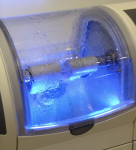Continuous flow… at the dentists’: Jidoka is the key to flow
Continuous flow is without debate a more effective way to work, but to many it seems impossible to reach in their current conditions – indeed, continuous flow requires an understanding of Jidoka as well.
I had the misfortune of spending a good while in the dentist’s chair as he tried to save a tooth. In the past, capping the tooth with a crown would involve two steps: first step, the dentist prepared the tooth by making an impression of the tooth with putty, then sending it to a lab to be manufactured. At the second step, two or three weeks later, he or she caps the tooth (the whole thing also often involved a temporary crown to protect the fragile tooth being work on).
I was amazed to see that the whole procedure now occurred in one session. My dentist prepared the tooth, cleaning it of decay, scanned the resulting cavity, then machined a cap from a bloc of ceramic, fitted it, baked it and, voilà, capped the tooth:

The “monument” process – the central lab dealing with all caps from all dentists was replaced by a small, local machine which fitted within the prepare-make-place cycle. In the same way, you can now enjoy an expresso at home with desktop machines, rather than have to go to the café down the road because only they have expresso machines. Continuous flow depends on transforming huge, volume processes in small, dedicated ones that fit in the flow.
This means that the skills of making the cap have been transferred from the central operations to the dentist by a key pillar of Judoka: separating human work from machine work. The dentist plugs in the specifications into the machine, the machine machines the ceramic bloc, and delivers a full cap: the dentist does not have to intervene in the machining process to get it right.
This, of course, is only possible by the radical improvement of measuring devices: the scanner that allows the dentist to make a 3D impression of the tooth and shape the plan on his screen before machining.
Jidoka, of course, is never perfect. Once the tooth is made, the dentist still has to spend a good half hour making it fit, polishing it so it is comfortable and so on. And, during the detailed finish, there was a scary moment where he feared I’d bitten too hard on the unbaked tooth to test placement, which would have broken the part, and added a whole cycle of rework to the procedure – but all was fine.
The three core elements of Jidoka are:
- Recognize abnormalities and stop-and-fix rather than put them aside and carry on with work
- Mistake-proofing devices to visualize when something is not right
- Separating human work from machine work: work is placed in the machine that then operates independently and delivers a finished part without human intervention
The savings of continuous flow are amazing: think about it how much one visit to the dentist as opposed to two saves in hassle for yourself and for the doctor, as well as how much is saved in “wasted” protection work for the tooth in the three week interval. But to achieve continuous flow, one must also understand and seek better “Jidoka” conditions, in order to transform large central “‘monument” processes into smaller, autonomous ones that fit within the flow.
Jidoka is the hidden key to flow.









